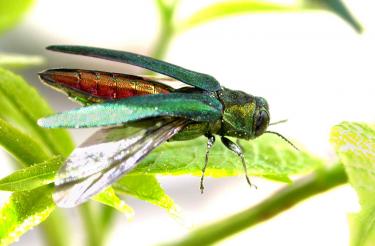When You Have an EAB Outbreak
Reporting ash borer sightings can help save other trees
If you discover emerald ash borers, your ash trees are probably going to die. But that will take years, and you have options in the meantime.
- Report it! The Emerald Ash Borer may be a regulatory concern in your state. If you think you have an outbreak make sure to report it to your state agricultural regulatory official.
- Do nothing. If you do nothing, the ash trees will die. The emerald ash borer kills nearly all ash trees that are larger than one inch in diameter—that is, all but the smallest saplings. Consider replanting native trees in the gaps left by the ash trees. Otherwise, weeds may move in.
- Remove ash trees. You can remove your ash trees before the emerald ash borer kills them. This is a clear choice if the dead tree would fall on a building, for example. Fallen trees can also block streams and cause flooding. Ash trees are safer to cut down while they're still alive. You may want to plant other native trees in their place.
- Treat with insecticide. If a tree's canopy still looks healthy, you can treat it with insecticides. This is too expensive to do for more than individual trees that you particularly treasure. The treatment will need to be repeated many times over the years.
- Deal with the victims. Consult with an expert on what to do with the wood from your ash trees. Since the emerald ash borer only damages the tissue right under the bark, the wood is still usable as lumber. It can also be used as firewood. Never move firewood out of the infested area. This can spread the beetles to healthy ash trees.
If emerald ash borers aren't in your area yet, you can start preparing your woods now.
Previous page
Next page
How can I get more tips?
It’s simple! Enter your email below.

